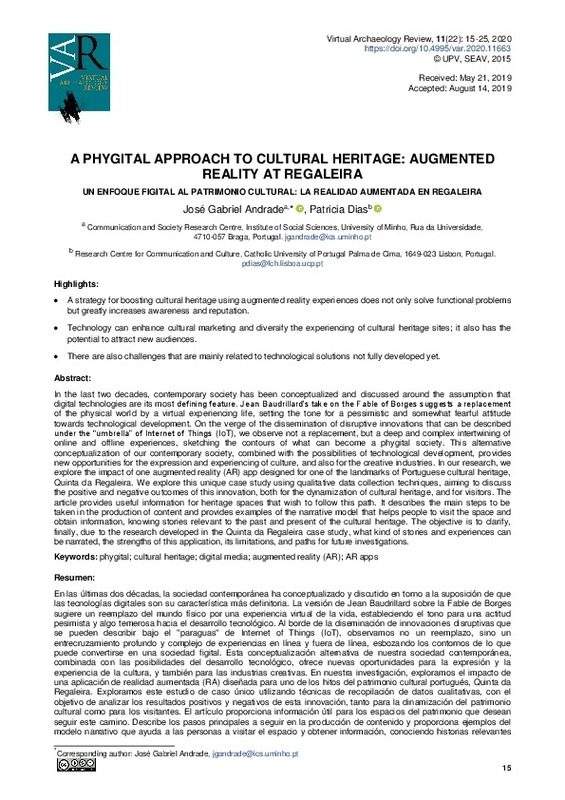JavaScript is disabled for your browser. Some features of this site may not work without it.
Buscar en RiuNet
Listar
Mi cuenta
Estadísticas
Ayuda RiuNet
Admin. UPV
A phygital approach to cultural heritage: augmented reality at Regaleira
Mostrar el registro sencillo del ítem
Ficheros en el ítem
| dc.contributor.author | Andrade, José Gabriel
|
es_ES |
| dc.contributor.author | Dias, Patrícia
|
es_ES |
| dc.date.accessioned | 2020-03-04T13:53:01Z | |
| dc.date.available | 2020-03-04T13:53:01Z | |
| dc.date.issued | 2020-01-28 | |
| dc.identifier.uri | http://hdl.handle.net/10251/138331 | |
| dc.description.abstract | [EN] In the last two decades, contemporary society has been conceptualized and discussed around the assumption that digital technologies are its most defining feature. Jean Baudrillard’s take on the Fable of Borges suggests a replacement of the physical world by a virtual experiencing life, setting the tone for a pessimistic and somewhat fearful attitude towards technological development. On the verge of the dissemination of disruptive innovations that can be described under the “umbrella” of Internet of Things (IoT), we observe not a replacement, but a deep and complex intertwining of online and offline experiences, sketching the contours of what can become a phygital society. This alternative conceptualization of our contemporary society, combined with the possibilities of technological development, affords new opportunities for the expression and experiencing of culture, and also for the creative industries. In our research, we explore the impact of one augmented reality (AR) app designe | es_ES |
| dc.description.abstract | [ES] En las últimas dos décadas, la sociedad contemporánea ha conceptualizado y discutido en torno a la suposición de que las tecnologías digitales son su característica más definitoria. La versión de Jean Baudrillard sobre la Fable de Borges sugiere un reemplazo del mundo físico por una experiencia virtual de la vida, estableciendo el tono para una actitud pesimista y algo temerosa hacia el desarrollo tecnológico. Al borde de la diseminación de innovaciones disruptivas que se pueden describir bajo el "paraguas" de Internet of Things (IoT), observamos no un reemplazo, sino un entrecruzamiento profundo y complejo de experiencias en línea y fuera de línea, esbozando los contornos de lo que puede convertirse en una sociedad figital. Esta conceptualización alternativa de nuestra sociedad contemporánea, combinada con las posibilidades del desarrollo tecnológico, ofrece nuevas oportunidades para la expresión y la experiencia de la cultura, y también para las industrias creativas. En nuestra inves | es_ES |
| dc.language | Inglés | es_ES |
| dc.publisher | Universitat Politècnica de València | es_ES |
| dc.relation.ispartof | Virtual Archaeology Review | es_ES |
| dc.rights | Reconocimiento - No comercial - Sin obra derivada (by-nc-nd) | es_ES |
| dc.subject | Phygital | es_ES |
| dc.subject | Cultural heritage | es_ES |
| dc.subject | Digital media | es_ES |
| dc.subject | Augmented reality (AR) | es_ES |
| dc.subject | AR apps | es_ES |
| dc.subject | Figital | es_ES |
| dc.subject | Patrimonio cultural | es_ES |
| dc.subject | Medios digitales | es_ES |
| dc.subject | Realidad aumentada (RA) | es_ES |
| dc.subject | Aplicaciones de RA | es_ES |
| dc.title | A phygital approach to cultural heritage: augmented reality at Regaleira | es_ES |
| dc.title.alternative | Un enfoque figital al patrimonio cultural: la realidad aumentada en Regaleira | es_ES |
| dc.type | Artículo | es_ES |
| dc.identifier.doi | 10.4995/var.2020.11663 | |
| dc.rights.accessRights | Abierto | es_ES |
| dc.description.bibliographicCitation | Andrade, JG.; Dias, P. (2020). A phygital approach to cultural heritage: augmented reality at Regaleira. Virtual Archaeology Review. 11(22):15-25. https://doi.org/10.4995/var.2020.11663 | es_ES |
| dc.description.accrualMethod | OJS | es_ES |
| dc.relation.publisherversion | https://doi.org/10.4995/var.2020.11663 | es_ES |
| dc.description.upvformatpinicio | 15 | es_ES |
| dc.description.upvformatpfin | 25 | es_ES |
| dc.type.version | info:eu-repo/semantics/publishedVersion | es_ES |
| dc.description.volume | 11 | es_ES |
| dc.description.issue | 22 | es_ES |
| dc.identifier.eissn | 1989-9947 | |
| dc.relation.pasarela | OJS\11663 | es_ES |
| dc.description.references | Anderson, E. F., McLoughlin, L., Liarokapis, F., Peters, C., Petridis, P., & Freitas, S. (2010). Developing serious games for cultural heritage: A state-of-the-art review. Virtual Reality, 14(4), 255-275. http://dx.doi.org/10.1007/s10055-010-0177-3 | es_ES |
| dc.description.references | Ardisonno, L., Kufflik, T., & Petrelli, D. (2012). Personalization in cultural heritage: the road travelled and the one ahead. User Model User-Adapter Interaction, 22(1-2), 73-99. https://doi.org/10.1007/s11257-011-9104-x | es_ES |
| dc.description.references | Bardin, L. (2011). Análise de Conteúdo. S. Paulo: Edições 70. | es_ES |
| dc.description.references | Barrile, V., Fotia, A., Bilotta, G., & Carlo, D. (2019). Integration of geomatics methodologies and creation of a cultural heritage app using augmented reality. Virtual Archaeology Review, 10(20), 40-51. https://doi.org/10.4995/var.2019.10361. | es_ES |
| dc.description.references | Baudrillard, J. (1994). Simulacra and Simulation. Michigan: University of Michigan Press. https://doi.org/10.3998/mpub.9904 | es_ES |
| dc.description.references | Blanco-Pons, S., Carrión-Ruiz, B., Lerma, J., & Villaverde, V. (2019). Design and implementation of an augmented reality application for rock art visualization in Cova dels Cavalls (Spain) Journal of Cultural Heritage, 39, 177-185. https://doi.org/10.1016/j.culher.2019.03.014 | es_ES |
| dc.description.references | Brumana, R., Oreni, D., Caspani, S., & Previtali, M. (2018). Virtual museums and built environment: narratives and immersive experience via multi-temporal geodata hub. Virtual Archaeology Review, 9(19), 34-49. https://doi.org/10.4995/var.2018.9918 | es_ES |
| dc.description.references | Castells, M. (2005). A era da informação: Economia, Sociedade e Cultura. Volume I: A sociedade em rede (p. 489). Lisboa: Fundação Calouste Gulbenkian. | es_ES |
| dc.description.references | Cortimiglia, M. N., Ghezzi, A., & Renga, F. (2011). Social applications: revenue models, delivery channels, and critical success factors: An exploratory study and evidence from the Spanish-speaking market. Journal of Theoretical and Applied Electronic Commerce Research, 6, 108-22. http://dx.doi.org/10.4067/S0718-18762011000200010 | es_ES |








